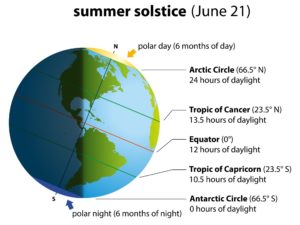On June 21, the world will witness two astronomical events: an annular solar eclipse visible in parts of India, and the summer solstice. The summer solstice of June is the longest day in the Northern Hemisphere.
 The summer solstice usually falls on June 21, and is said to mark the onset of summer in the Northern Hemisphere. It occurs when the North Pole is the nearest to the Sun. It is derived from the Latin word ‘sol‘ which means ‘sun’, and ‘sistere‘, which means ‘to stand still’ and occurs two times in a year, once in each hemisphere.
The summer solstice usually falls on June 21, and is said to mark the onset of summer in the Northern Hemisphere. It occurs when the North Pole is the nearest to the Sun. It is derived from the Latin word ‘sol‘ which means ‘sun’, and ‘sistere‘, which means ‘to stand still’ and occurs two times in a year, once in each hemisphere.
The Earth’s rotational axis is tilted at an angle of about 23.5 degrees from vertical.
As the Earth orbits the sun, the Northern Hemisphere is angled toward the sun for six months and angled away from the sun for the other six months of the year.
When the Northern Hemisphere is tilted towards the sun, sunlight falls at a steeper angle causing the hot months of summer.
The moment the North Pole is nearest to Sun, the Northern Hemisphere experiences the Summer Solstice. At the same time, the South Pole is farthest from the Sun, and hence, the Southern Hemisphere experiences the Winter Solstice, i.e. the longest night, and consequently the shortest day in the year.
The Summer Solstice is seen as an auspicious day in many cultures.
